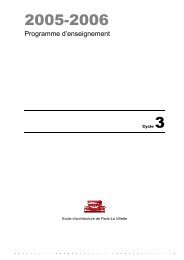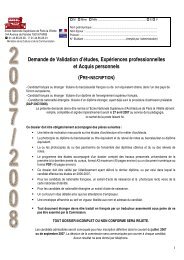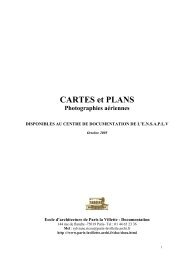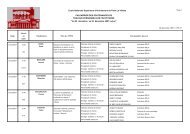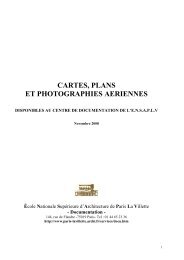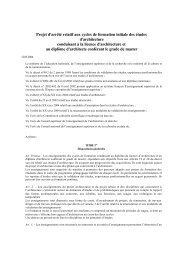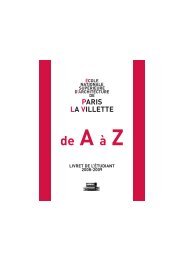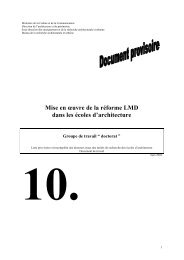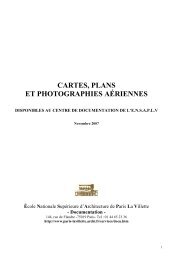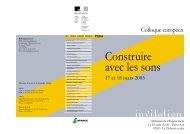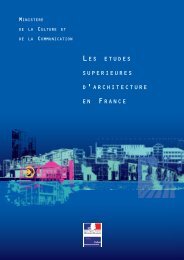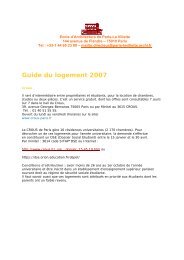Transmitting the past to the future : - Ecole Nationale Supérieure d ...
Transmitting the past to the future : - Ecole Nationale Supérieure d ...
Transmitting the past to the future : - Ecole Nationale Supérieure d ...
You also want an ePaper? Increase the reach of your titles
YUMPU automatically turns print PDFs into web optimized ePapers that Google loves.
6<br />
of things – an idea which, as we have seen, was expressed several centuries later by Zong Bing<br />
when he defined <strong>the</strong> principles of landscape painting, and which, down <strong>to</strong> contemporary attitudes<br />
<strong>to</strong>ward <strong>the</strong> protection of cultural heritage, has profoundly influenced <strong>the</strong> conception of reality in<br />
East Asia. The very idea of "cultural assets not having a form" has here its origin; and this clearly<br />
shows that what is at stake here is <strong>the</strong> possibility <strong>to</strong> take human existence in<strong>to</strong> account.<br />
As a matter of fact, such a conception of <strong>the</strong> "greater form" of things, exceeding <strong>the</strong>ir<br />
"external shape" and which is <strong>the</strong>ir true reality, implies an existential conception of being and of<br />
identity, integrating <strong>the</strong> human and <strong>the</strong> environment in<strong>to</strong> one reality. Now, this can definitely not<br />
be grasped within <strong>the</strong> conceptual frame of <strong>the</strong> modern Western paradigm, which radically<br />
dissociates <strong>the</strong> subjective from <strong>the</strong> objective. And here is indeed <strong>the</strong> dead end of this paradigm:<br />
tremendously effective though it may be, it cannot take human existence in<strong>to</strong> account; it can only<br />
juxtapose individual subjects and individual objects.<br />
4. Sustainable identity<br />
I am using here <strong>the</strong> word "existence" in its original meaning, 17 that which Heidegger made use of<br />
in Sein und Zeit and <strong>to</strong> which corresponds his concept of Ausser-sich-sein, "being-outside-ofoneself".<br />
It is profoundly alien <strong>to</strong> <strong>the</strong> conception of identity which, since Aris<strong>to</strong>telian logic,<br />
founded rational inference in Europe and is at <strong>the</strong> origin of modern science. In this logic, A is<br />
not non-A. There no possible intermediate being between what <strong>the</strong> thing is (A) and what it is not<br />
(non-A). There is only <strong>the</strong> identity (A) of a substantial being (ousia), or <strong>the</strong> negation of this<br />
identity (non-A) by <strong>the</strong> o<strong>the</strong>rness of ano<strong>the</strong>r substantial being. This conception of identity is in<br />
tune with Aris<strong>to</strong>tle's conception of place (<strong>to</strong>pos) as <strong>to</strong> <strong>to</strong>u periechon<strong>to</strong>s peras akinê<strong>to</strong>n prô<strong>to</strong>n, "<strong>the</strong><br />
immediate immobile enveloping limit" (Physika, 212 a 20) of a being. This would be <strong>to</strong> say that<br />
<strong>the</strong> place, and correlatively <strong>the</strong> identity of a thing, is limited <strong>to</strong> what is called its external shape<br />
(waixing) in <strong>the</strong> Chinese tradition, or <strong>the</strong> Vessel (Qi) in <strong>the</strong> Great Commentary of <strong>the</strong> Yi jing.<br />
Obviously, <strong>the</strong> Taoist concept of "greater form", and, by <strong>the</strong> same <strong>to</strong>ken, <strong>the</strong> Heideggerian<br />
concept of "being-outside-of-oneself", are incompatible with Aris<strong>to</strong>telian logic.<br />
Now, <strong>the</strong> Japanese philosopher Nishida Kitarô ( 西 田 幾 多 郎 , 1870-1945) has shown that<br />
<strong>the</strong> reality of wordliness (sekaisei 世 界 性 ) cannot be grasped by Aris<strong>to</strong>telian logic, <strong>to</strong> which he<br />
opposed what he called "logic of place", basho no ronri 場 所 の 論 理 , or "logic of <strong>the</strong> predicate",<br />
jutsugo no ronri 述 語 の 論 理 . This amounts <strong>to</strong> saying (what follows is not Nishida’s proper<br />
argument, but my own) that <strong>the</strong> world is <strong>the</strong> <strong>to</strong>tal set of predicates by dint of which, through our<br />
senses, thoughts, words and actions, we grasp <strong>the</strong> reality of things; whereas Aris<strong>to</strong>telian logic<br />
amounts <strong>to</strong> saying that this reality precedes and founds such predicates. In this sense, it negates<br />
worldliness, and this is precisely, as Heidegger and Koyré have made clear, what <strong>the</strong> modern<br />
paradigm brings forth (i.e. it tends <strong>to</strong> reduce <strong>the</strong> world <strong>to</strong> a universal object).<br />
Nishida's philosophy was deemed by his followers, <strong>the</strong> Kyo<strong>to</strong> school (Kyô<strong>to</strong> gakuha 京 都<br />
学 派 ), an "overcoming of modernity" (kindai no chôkoku 近 代 の 超 克 ). 18 For what concerns us<br />
here, this "overcoming" consists in showing that identity cannot be reduced <strong>to</strong> an Aris<strong>to</strong>telian<br />
<strong>to</strong>pos; it necessarily supposes a "place", basho, 場 所 which is relational and <strong>the</strong>refore exceeds any<br />
individual <strong>to</strong>pos, be it that of things or of persons.<br />
The Nishidian concept of basho is in tune with both <strong>the</strong> Heideggerian concept of Aussersich-sein<br />
and <strong>the</strong> Taoist concept of Da Xiang. By <strong>the</strong> same <strong>to</strong>ken, <strong>the</strong>se three concepts are<br />
incompatible with <strong>the</strong> paradigm of modernity in general, and with modern science in particular. It<br />
would be <strong>to</strong>o long <strong>to</strong> show here that, in fact, Nishida's philosophy is not an overcoming but a<br />
reversal of modernity. 19 However, <strong>the</strong> idea that worldliness is predicative, not substantial, gives us<br />
an essential clue for understanding why, in <strong>the</strong> concreteness of existence, <strong>the</strong> identity of persons<br />
and that of things intermingle creatively in<strong>to</strong> one reality ; whereas <strong>the</strong> modern paradigm, by<br />
17 The Latin etymology of existence means "<strong>to</strong> stay" (stare) "coming outside" (ex). That is, literally, <strong>to</strong> exceed <strong>the</strong> outer<br />
limit of one's material form. In o<strong>the</strong>r words, existence is relational and cannot be reduced <strong>to</strong> individual substances.<br />
18 For a recent international discussion of this question, see Augustin BERQUE (ed.), Logique du lieu et dépassement de la<br />
modernité (Logic of place and <strong>the</strong> overcoming of modernity), Brussels : Ousia, 2000, 2 vol.<br />
19 This is because Nishida absolutized worldliness, which amounts <strong>to</strong> saying that predicates create <strong>the</strong>ir subjects, and<br />
that words produce <strong>the</strong> things <strong>the</strong>y are about. This absolute constructivism is obviously false. For more arguments,<br />
see my Écoumène. Introduction à l'étude des milieux humains, Paris: Belin, 2000 (Japanese translation Fûdogaku josetsu 風 土<br />
学 序 説 , Tokyo : Chikuma Shobo, 2000).



